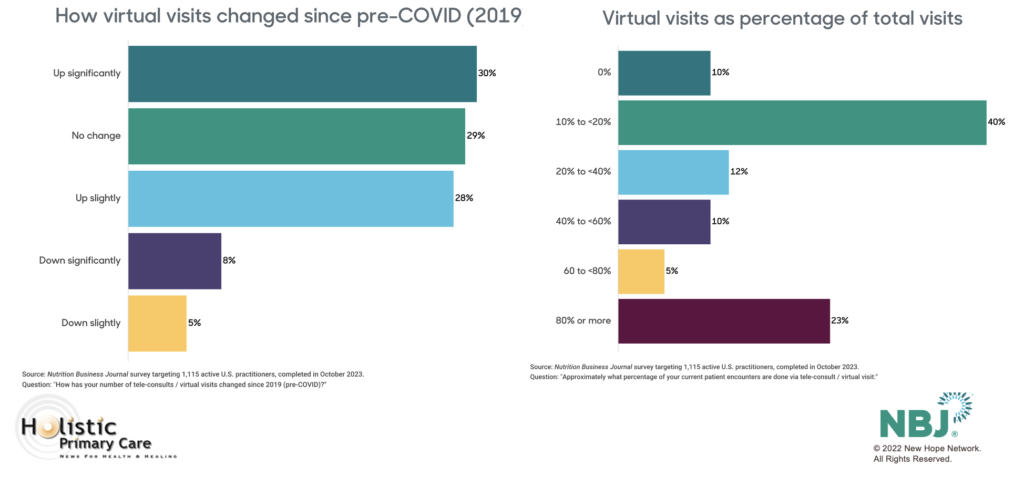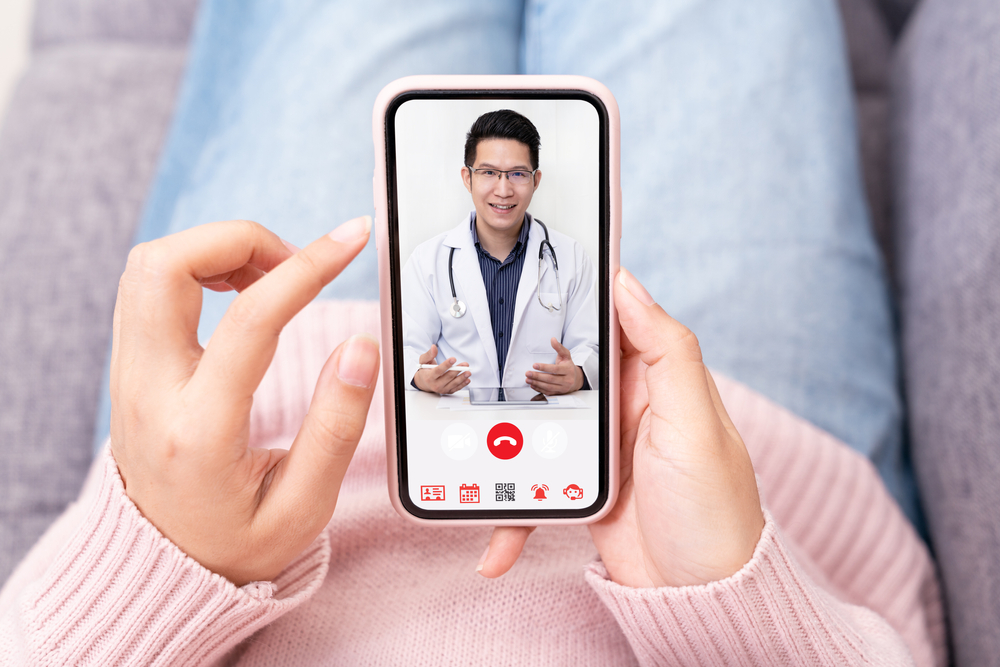
Telemedicine is now commonplace in holistic medical practices, and practitioners who offer teleconsultations are very satisfied with the experience.
That’s one of the main findings from Holistic Primary Care’s 2023 practitioner survey, conducted over the summer in collaboration with Nutrition Business Journal.
The 70-question survey covered a broad range of topics—from the impact of the Covid pandemic to the role of dietary supplements and herbs in patient care. We gathered data from 1,151 practitioners representing diverse clinical disciplines and modes of practice.
The participants were drawn from Holistic Primary Care’s readership, and from the client databases of several prominent practitioner-focused supplement companies via Nutrition Business Journal.
Age-wise the cohort skewed older: 54% were between the ages of 45 and 64 years old, and 24% were 65 and above, while 17% were under 45. Three-quarters of the cohort have been in practice for at least 10 years, and 29% have been practicing for 30 years or more. The majority of respondents were female (61% versus 32% male), a trend we’ve observed in most of our past surveys.
The cohort included responses from (in descending order): chiropractors, medical doctors, naturopathic doctors, nurses, wellness coaches, acupuncturists, dietitians and nutrition professionals, as well as a smattering of other practitioner types.
Virtual Visits Surge
Telemedicine, which grew exponentially nationwide during the Covid pandemic, was an important theme in this year’s survey, as we sought to understand the impact of this technological phenomenon on holistic practices, and on the relationships between practitioners and their patients.
Fifty-eight percent of our survey respondents indicated that they currently provide virtual visits for at least some of their patients, and 30% report that their volume of virtual visits increased significantly since the Covid pandemic. Another 28% said teleconsults are up slightly since the start of the pandemic.
We expected to see a large age-associated variation in engagement with telemedicine. The data did indicate a somewhat greater level of engagement among younger practitioners: 66% of those under the age of 45 offer virtual visits, versus 55% among the clinicians over age 60. But that difference was not dramatic, and telemed engagement is high in all age brackets.
It was also high across all practitioner types and practice settings, though the number of respondents offering virtual visits was quite a bit higher among practitioners with conventional allopathic training (the MDs, DOs, RNs, NPs) compared with the DCs, NDs, and others with non-allopathic “alternative medicine” training (73% vs 54%).

There’s no question that teleconsults have become a routine part of patient care in many clinics, but they haven’t entirely replaced old fashioned face-to-face visits. The majority of practitioners (62%) currently offering virtual visits say these represent less than 40% of total patient encounters. Fully half say virtual visits make up less than 20% of all visits.
That said, for almost one-quarter of these practices (23%), virtual visits account for 80% of all encounters.
Satisfaction is High
Practitioners who use telemedicine like it a lot: 45% describe themselves as “very satisfied” with their telemedicine experience, and 41% say they’re somewhat satisfied. In contrast, only 14% expressed any degree of dissatisfaction.
Our findings track with general trends seen throughout healthcare. According to a large nationwide survey of office-based physicians published early in 2023 by the Office of the National Coordinator for Health Information Technology (ONC), the number of doctors using telemedicine increased six-fold from 15% in 2018, to 87% by the beginning of 2019.
The spectacular growth of virtual visits over the last five years was driven largely by necessity during the first year of the pandemic, when the virus was spreading rapidly, many people were dying or severely ill, and in-person medical encounters suddenly became a high-risk proposition.
It was also fueled by a “temporary” suspension of HIPAA (Health Insurance Portability & Accountability Act) regulations that had, prior to Covid, hindered the evolution of telemedicine. Massive federal and regional government spending on telehealth infrastructure and oversight, combined with enthusiastic investment from Big Tech and venture capital also played a role.
Changes to coding systems that enabled practitioners to bill for virtual visits certainly helped as well.
Our stats on telemedicine use are not quite as high as ONC’s, but this is not surprising because the ONC survey showed that the largest growth in telemedicine was among practitioners in large group practices, and in Patient-Centered Medical Homes or Merit-Based Incentive Systems practice models. These are not practice settings that have typically been friendly to holistic and functional medicine.
The HPC/NBJ cohort is largely comprised of practitioners in solo (70%) or small-group practices (19%), and direct cash-pay (54%) or mixed cash/insurance (28%) practice models.
Limitations of Virtual Visits
Further, there are many holistic modalities—chiropractic adjustments, acupuncture, and massage, for example—that simply cannot be done remotely. And much of the appeal of holistic medicine, for patients and practitioners alike, is its relationality and direct emotional connection. To some extent, these aspects are diminished in a techn-mediated remote encounter.
In terms of improving access, telemedicine has been a big plus for many people, especially those in rural areas who live far from the nearest clinic, and also those whose mobility is limited by age, illness, or disability. It provides unparalleled convenience, particularly when they need attention for minor health concerns or follow-ups, that don’t really require in-person contact.
According to a Kaiser Permanente survey of 1,000 northern California patients who’d had remote consults with Kaiser physicians between March and October 2020, 80% reported that the virtual visit(s) met their medical needs as well as in-person visits, and almost 20% said they actually preferred seeing their doctors remotely rather than in person.
Metova, a custom software provider, fielded a survey of over 1,000 people in the summer of 2020, and found that 80% of those who’d experienced a virtual visit would gladly choose telemedicine for subsequent visits if given that option.

Other studies of patient experiences with and attitudes toward telemedicine have come to a similar conclusion that, on the whole, telehealth is a big hit with the public.
All that being said, telemedicine does have its drawbacks. Though it can improve patient access to care in some cases, it also categorically excludes people who do not have mobile phones or computers.
Who’s Excluded?
Jacqueline Fincher, MD, a rural primary care physician in Thompson, GA, and president of the American College of Physicians from 2020-2021 at the height of the pandemic, told Holistic Primary Care that in her area of eastern Georgia, many of the people who would potentially benefit from telemedicine have no way to access it.
“It takes good audio and video on both ends—the patient and the practitioner—for remote consults to work. At least 30% of the time, at least one of those parts doesn’t work properly. Sometimes, it’s just not an option in rural areas, because the (internet) bandwidth just isn’t there to support it.”
Dr. Fincher added that in her area, a majority of her most vulnerable patients—the poor, the elderly, the less educated—do not own smartphones, laptops, or any other digital technology. “I still have a lot of patients who are using landlines only. I can talk with them, but I can’t see them, can’t observe them. It is very limited.”
A 2021 report by the Pew Research Center shows that while mobile phone ownership is very high in the US, approximately 15% of the adult population does not own a smartphone.
Great…When It Works
And like all things technological, virtual visit platforms are wonderful when they work properly….but often enough, they do not. Tech glitches can cause consternation for practitioners and patients alike.
In 2022, UnitedHealth Group and Optum posted a survey of 240 practitioners representing a wide range of specialties and practice settings. While 69% described telemedicine as “convenient,” 28% said their first-choice descriptor was “frustrating.” Half said they experienced difficulties navigating the teleconsult platforms.
Surveys of patients show a similar aggravation with the technology. Further, some patients report that they have difficulty finding quiet private places at home or in their offices, in which to have consultations with medical professionals. And on both the practitioner and patient side, there are concerns about confidentiality, and the possibility that hackers could access the platforms and steal intimate personal information.
Telemedicine will never entirely eliminate in person clinic visits. But our survey and many others show that for many medical practices—including holistic, functional, and even chiropractic clinics—it has become a prominent part of day-to-day patient care. And for nearly a quarter of our respondents, virtual visits are the main mode of contact with patients.
Though it has some drawbacks, the benefits of telemedicine far outweigh the downsides, and it will be an increasingly important facet of healthcare in the years to come.
Nutrition Business Journal’s comprehensive 2023 Healthcare Practitioner Channel report, based on the complete data set from our collaborative survey, is available for purchase at: https://store.newhope.com/pages/nbj-2023-reports.







